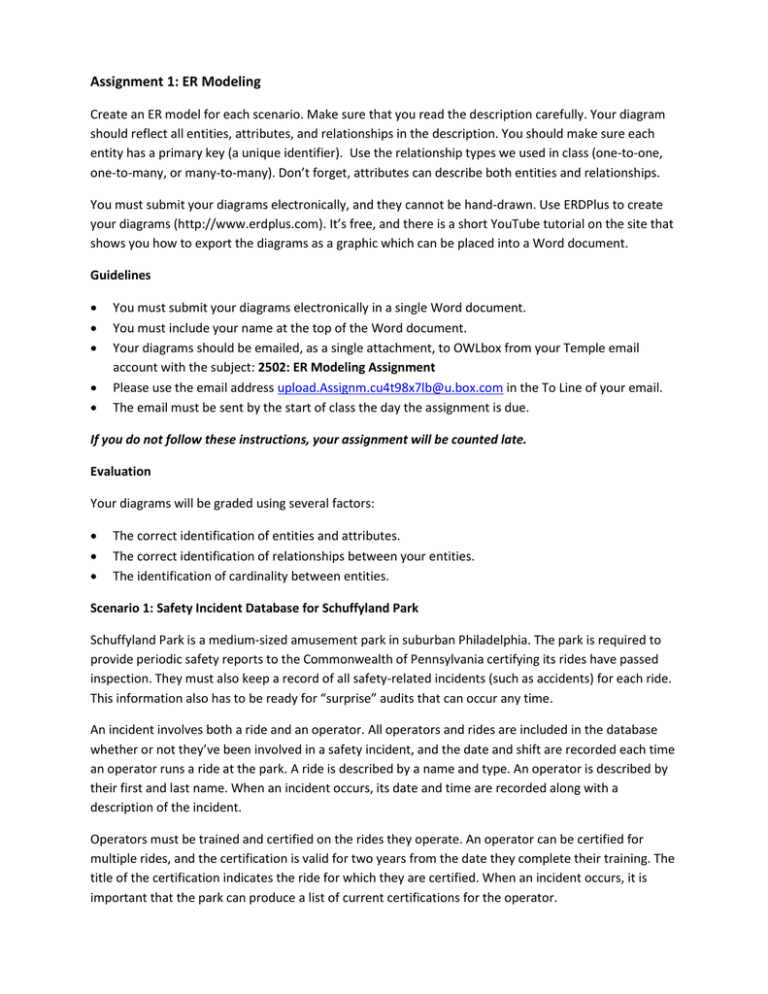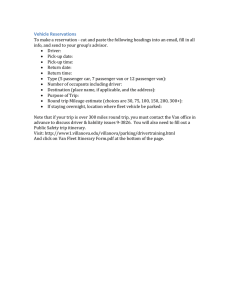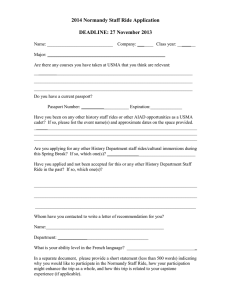Assignment #1 ER Modeling
advertisement

Assignment 1: ER Modeling Create an ER model for each scenario. Make sure that you read the description carefully. Your diagram should reflect all entities, attributes, and relationships in the description. You should make sure each entity has a primary key (a unique identifier). Use the relationship types we used in class (one-to-one, one-to-many, or many-to-many). Don’t forget, attributes can describe both entities and relationships. You must submit your diagrams electronically, and they cannot be hand-drawn. Use ERDPlus to create your diagrams (http://www.erdplus.com). It’s free, and there is a short YouTube tutorial on the site that shows you how to export the diagrams as a graphic which can be placed into a Word document. Guidelines You must submit your diagrams electronically in a single Word document. You must include your name at the top of the Word document. Your diagrams should be emailed, as a single attachment, to OWLbox from your Temple email account with the subject: 2502: ER Modeling Assignment Please use the email address upload.Assignm.cu4t98x7lb@u.box.com in the To Line of your email. The email must be sent by the start of class the day the assignment is due. If you do not follow these instructions, your assignment will be counted late. Evaluation Your diagrams will be graded using several factors: The correct identification of entities and attributes. The correct identification of relationships between your entities. The identification of cardinality between entities. Scenario 1: Safety Incident Database for Schuffyland Park Schuffyland Park is a medium-sized amusement park in suburban Philadelphia. The park is required to provide periodic safety reports to the Commonwealth of Pennsylvania certifying its rides have passed inspection. They must also keep a record of all safety-related incidents (such as accidents) for each ride. This information also has to be ready for “surprise” audits that can occur any time. An incident involves both a ride and an operator. All operators and rides are included in the database whether or not they’ve been involved in a safety incident, and the date and shift are recorded each time an operator runs a ride at the park. A ride is described by a name and type. An operator is described by their first and last name. When an incident occurs, its date and time are recorded along with a description of the incident. Operators must be trained and certified on the rides they operate. An operator can be certified for multiple rides, and the certification is valid for two years from the date they complete their training. The title of the certification indicates the ride for which they are certified. When an incident occurs, it is important that the park can produce a list of current certifications for the operator. (problem description continues on next page…) Inspection records are also recorded in the database. An inspection occurs at a particular date and time, with a numeric score from 1 to 5, and notes about the outcome of the inspection. There is only one ride per inspection, even if multiple inspections are done by the same inspector on the same day and time. The information that needs to be recorded about the inspector is their first and last name. Scenario 2: Tracking Trips for the SchUber Taxi Service A new Philadephia startup called SchUber is a matching service between freelance taxi drivers and passengers. The database to support the service tracks trips, customer accounts, and includes a rating system where drivers and passengers can rate each other. The basic transaction for SchUber is the trip. A trip is described by the date and time the trip occurs and the fare. A trip involves one driver and at least one passenger. A driver has a first name, a last name, a social security number, and an email address. A passenger has a first name, last name, and an email address. A trip is also associated with at least two addresses. An address is also described by the street address, city, state, and zip code. Each address must be designated as either an origin or destination address for the trip. Each address also has an attribute which designates the address as a home address for a passenger – this is useful for billing and for making a request for a home pick-up. However, a passenger can only have one address (their home address) associated with their account. A passenger pays for the trip using any one of the payment methods linked to their account. Valid payment method types are PayPal, Credit Card, or Google Wallet. Credit cards also have an expiration date, but this information is not needed for PayPal or Google Wallet. Passengers cannot share a payment method, but if there are multiple passengers on a trip they can each pay their share, and each of their payments can be a different amount (which should be recorded in the database) to the fare. The rating system is one of the key features of SchUber. Both drivers and passengers can have ratings, although they may not have any ratings, especially if they just started with the service. When a driver or a passenger submits the rating, they give a star rating (1 to 5), brief comments, and the type of review (i.e., for driver or for passenger). SchUber users can look up ratings by driver, passenger, or by trip (a trip could have more than two ratings if there were multiple passengers on the trip).


